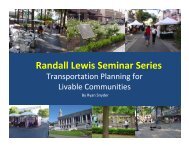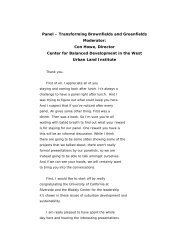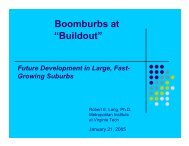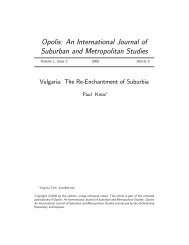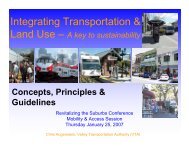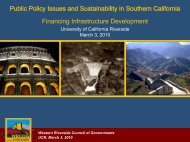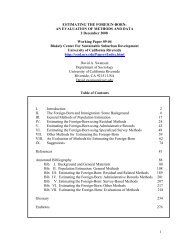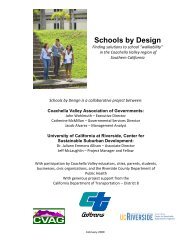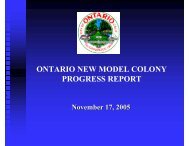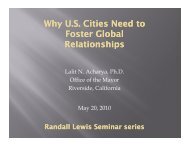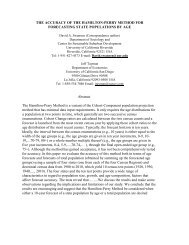Latino New Urbanism: Building on Cultural Preferences - Center for ...
Latino New Urbanism: Building on Cultural Preferences - Center for ...
Latino New Urbanism: Building on Cultural Preferences - Center for ...
Create successful ePaper yourself
Turn your PDF publications into a flip-book with our unique Google optimized e-Paper software.
that nearly 40 percent of all <str<strong>on</strong>g>Latino</str<strong>on</strong>g><br />
homeowners indicated that “more<br />
room <strong>for</strong> a growing family” was the<br />
main reas<strong>on</strong> <strong>for</strong> purchasing a home.<br />
This greatly overshadowed the sec<strong>on</strong>d<br />
str<strong>on</strong>gest reas<strong>on</strong>, homeownership as<br />
a <strong>for</strong>m of financial investment,<br />
identified by <strong>on</strong>ly 22 percent of survey<br />
resp<strong>on</strong>dents (Kotkin and Tseng 2002).<br />
<str<strong>on</strong>g>Latino</str<strong>on</strong>g> family dominance in c<strong>on</strong>sumer<br />
spending can best be explained by<br />
marketing analyst M. Isabel Valdes’<br />
(2000) “ecosystemic” model, which<br />
approaches c<strong>on</strong>sumers from the<br />
perspective of the individual and his or<br />
her relati<strong>on</strong>ship with society. This<br />
model enables evaluati<strong>on</strong> of how<br />
individuals from different cultures<br />
interact between and within the various<br />
layers of society.<br />
The ecosystemic model reveals<br />
several important aspects of the <str<strong>on</strong>g>Latino</str<strong>on</strong>g><br />
decisi<strong>on</strong>-making process. The <str<strong>on</strong>g>Latino</str<strong>on</strong>g><br />
individual attempts to make his or her<br />
decisi<strong>on</strong>s c<strong>on</strong>sistent with the needs of<br />
the family, whereas the Anglo<br />
individual tends to make decisi<strong>on</strong>s<br />
unilaterally. <str<strong>on</strong>g>Latino</str<strong>on</strong>g>s are more likely to<br />
focus <strong>on</strong> relati<strong>on</strong>ships, while Anglos<br />
are inclined to be task-oriented. For<br />
Anglos, individual achievement<br />
dominates, whereas <strong>for</strong> <str<strong>on</strong>g>Latino</str<strong>on</strong>g>s, family<br />
interdependence takes priority.<br />
The ecosystemic model dem<strong>on</strong>strates<br />
the need <strong>for</strong> the home building industry<br />
to acknowledge that interacti<strong>on</strong>s within<br />
the <str<strong>on</strong>g>Latino</str<strong>on</strong>g> family are different than<br />
those of Anglos. Family<br />
interdependency may explain why<br />
more <str<strong>on</strong>g>Latino</str<strong>on</strong>g>s have multiple<br />
generati<strong>on</strong>al households, adult<br />
children remaining at home l<strong>on</strong>ger than<br />
Mendez: <str<strong>on</strong>g>Latino</str<strong>on</strong>g> <str<strong>on</strong>g>New</str<strong>on</strong>g> <str<strong>on</strong>g>Urbanism</str<strong>on</strong>g><br />
43<br />
n<strong>on</strong>-<str<strong>on</strong>g>Latino</str<strong>on</strong>g>s, or why <str<strong>on</strong>g>Latino</str<strong>on</strong>g>s adapt their<br />
homes to facilitate social interacti<strong>on</strong>.<br />
Corresp<strong>on</strong>dingly, since <str<strong>on</strong>g>Latino</str<strong>on</strong>g>s tend to<br />
<strong>for</strong>m str<strong>on</strong>g b<strong>on</strong>ds within the family and<br />
are supportive of their communities,<br />
housing developments should be<br />
produced that reflect these cultural<br />
values and preferences. As discussed<br />
with houses and parks, <str<strong>on</strong>g>Latino</str<strong>on</strong>g>s are<br />
already adapting the built envir<strong>on</strong>ment<br />
to maximize social interacti<strong>on</strong> and<br />
activities c<strong>on</strong>sistent with compact city<br />
lifestyles. However, housing<br />
developments should also<br />
acknowledge the external variables<br />
influencing <str<strong>on</strong>g>Latino</str<strong>on</strong>g> households,<br />
specifically housing af<strong>for</strong>dability, and<br />
develop methods to effectively address<br />
those variables.<br />
<str<strong>on</strong>g>Latino</str<strong>on</strong>g> Ec<strong>on</strong>omic C<strong>on</strong>straints<br />
Various reports and publicati<strong>on</strong>s cite<br />
the enormous purchasing power of<br />
<str<strong>on</strong>g>Latino</str<strong>on</strong>g>s. Hispanic Business magazine<br />
reports that the purchasing power of<br />
US <str<strong>on</strong>g>Latino</str<strong>on</strong>g>s reached $540 billi<strong>on</strong> in<br />
2002, and their purchasing power in<br />
Cali<strong>for</strong>nia has been estimated at<br />
around $171 billi<strong>on</strong> with a projected<br />
increase of up to $260 billi<strong>on</strong> by 2007<br />
(Kotkin and Tseng 2002). Though the<br />
estimates of <str<strong>on</strong>g>Latino</str<strong>on</strong>g> purchasing power<br />
are impressive, they overlook the<br />
realities and c<strong>on</strong>straints <str<strong>on</strong>g>Latino</str<strong>on</strong>g>s<br />
encounter in Cali<strong>for</strong>nia’s home<br />
purchasing market.<br />
At present, fewer than 15 percent of<br />
<str<strong>on</strong>g>Latino</str<strong>on</strong>g> families can af<strong>for</strong>d the state’s<br />
median priced home at $321,121. On<br />
the other hand, 43 percent of white<br />
families are able to af<strong>for</strong>d that same<br />
home. A family earning the state’s<br />
median <str<strong>on</strong>g>Latino</str<strong>on</strong>g> family income of<br />
$35,000 would need an additi<strong>on</strong>al



